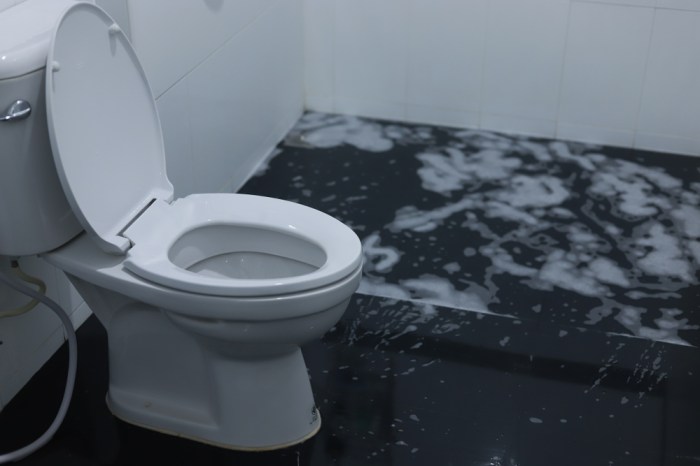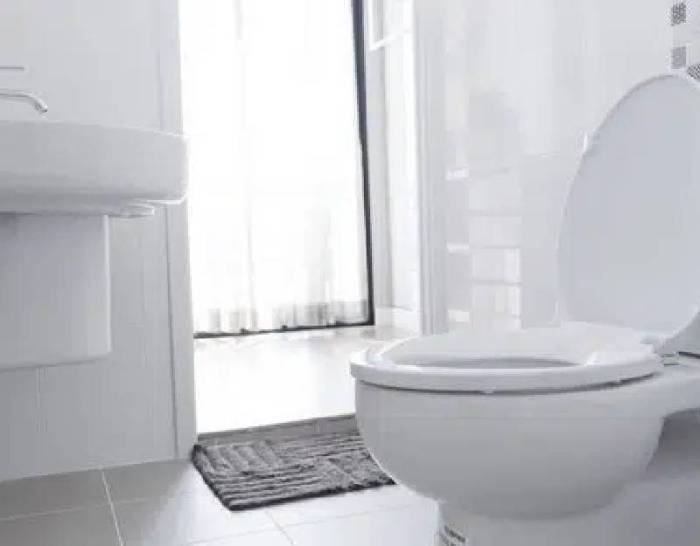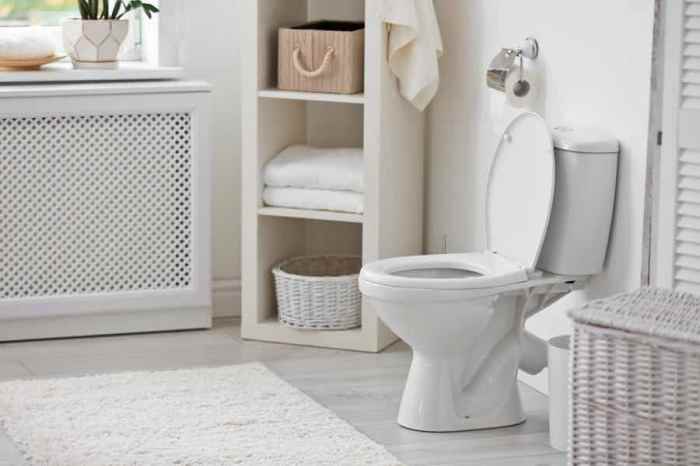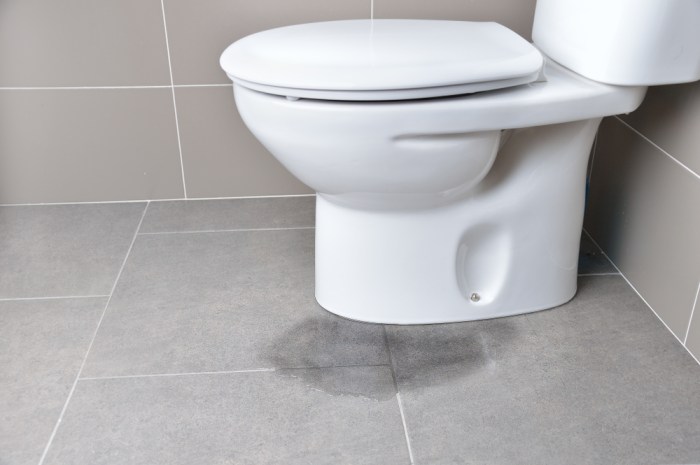Sewer Water Coming Up Toilet A Guide
Sewer water coming up toilet is a frustrating plumbing problem. This guide explores the causes, potential solutions, preventative measures, and safety considerations to effectively address this issue. Understanding the root cause is crucial for a successful repair.
From clogged pipes to faulty drains, various factors can contribute to sewer water backing up into a toilet. This comprehensive guide provides a systematic approach to identify the source of the problem, offering both DIY solutions and when professional help is necessary. We’ll also explore simple preventative measures to keep your plumbing system healthy.
Problem Description: Sewer Water Coming Up Toilet
Sewer water backing up into a toilet is a common plumbing issue that can cause significant inconvenience and potential health hazards. This unpleasant event typically arises from blockages or malfunctions within the drainage system, forcing wastewater to find an alternative path, often into the home. Understanding the causes and symptoms can help homeowners quickly identify and address the problem.
A variety of factors can lead to sewer water backing up into a toilet. These range from simple clogs to more complex issues within the plumbing infrastructure, potentially necessitating professional intervention. This detailed explanation provides a framework for comprehending the problem, including common causes, indicators, and troubleshooting strategies.
Causes of Sewer Water Backup
A thorough understanding of the potential causes allows homeowners to diagnose and address the issue promptly. A range of factors can contribute to sewer water backing up into a toilet. These include, but are not limited to, clogs in the plumbing system, issues with the drainpipes themselves, and even problems beyond the home’s immediate plumbing.
Common Causes
Several factors can lead to the unpleasant situation of sewer water backing up into a toilet. These are broadly categorized into issues with the home’s plumbing system and those potentially originating outside the house.
- Clogged Pipes: Blockages in pipes, often caused by flushed items like sanitary napkins, paper towels, or excessive amounts of toilet paper, can restrict the flow of water, creating a buildup of pressure. This pressure can cause sewer water to back up into the toilet. Over time, gradual blockages from grease buildup or other debris can also contribute to this problem.
- Faulty Drainpipes: Damaged or corroded drainpipes can weaken or rupture, leading to insufficient water flow and pressure. This can result in water backing up from the sewer line into the home’s plumbing.
- Tree Roots: Tree roots can penetrate plumbing lines, creating blockages that restrict water flow. This is a common issue in older homes or those with trees near the plumbing infrastructure. In such cases, roots can cause significant damage and are often a complex problem requiring professional attention.
- External Sewer Line Issues: Problems with the sewer line outside the home, such as collapses, blockages, or insufficient slope, can cause wastewater to back up into the house’s plumbing system. This often manifests as a recurring problem, requiring specialized assessment and resolution.
Signs and Symptoms
Recognizing the signs and symptoms of sewer water backing up into a toilet is crucial for prompt action. Early detection can prevent further damage and discomfort.
- Slow Draining: A noticeable reduction in the speed of water draining from the toilet or other plumbing fixtures can be an early warning sign of a potential clog. This slow draining often precedes more severe backups.
- Gurgling Sounds: Unusual gurgling noises emanating from the drains can indicate a blockage or pressure buildup in the plumbing system, potentially leading to sewer water backup.
- Water Backing Up: The most obvious symptom is water backing up into the toilet bowl or other fixtures, visibly filling up or overflowing.
- Strong Odors: Unpleasant odors emanating from the drains suggest a blockage that is allowing sewer gases to escape into the home.
Troubleshooting and Identification
Systematic troubleshooting is essential to pinpoint the source of the problem. A methodical approach can help determine the location and nature of the issue.
- Inspect the Toilet and Surrounding Area: Start by visually inspecting the toilet and the immediate area for any signs of clogs or damage. Check for any unusual sounds or smells coming from the drains.
- Check Other Plumbing Fixtures: Inspect other plumbing fixtures in the home, such as sinks and showers, to see if they exhibit similar problems like slow draining or gurgling sounds. This can help determine if the issue is localized or widespread.
- Examine the Drainpipes: If possible, examine the visible drainpipes to look for signs of damage, clogs, or unusual buildup. Careful inspection can provide valuable insights into the potential cause.
Possible Causes and Symptoms
The following table summarizes potential causes and associated symptoms of sewer water backup into a toilet:
| Possible Cause | Symptoms | Likely Location | Severity |
|---|---|---|---|
| Clogged pipes | Slow draining, gurgling sounds, water backing up | Plumbing lines | Medium |
| Faulty drain | Constant overflow, strong odors | Drainpipe | High |
| Tree root intrusion | Slow draining, gurgling sounds, constant backup, noticeable odor | Plumbing lines, sewer line | High |
| External sewer line issues | Frequent backups, water pooling around the sewer line | Outside sewer line | High |
Potential Solutions

Source: rooterjohn.com
Toilet backups are frustrating, but thankfully, various solutions can resolve the issue. Understanding the cause and implementing the appropriate fix is key to restoring proper drainage and preventing future problems. Different methods vary in complexity and cost, so careful consideration is important.
Common Repair Methods, Sewer water coming up toilet
Common solutions for sewer water backing up into a toilet often involve addressing blockages within the plumbing system. These solutions range from straightforward DIY fixes to more involved professional interventions.
Using a Plunger
Using a plunger is a relatively inexpensive and accessible method for unclogging a toilet drain. Its effectiveness depends on the severity of the blockage. A simple, yet effective method, it’s particularly useful for minor clogs.
- Ensure the water level in the bowl is high enough to fully submerge the plunger’s cup.
- Place the plunger over the drain opening, creating a tight seal.
- Pump the plunger vigorously, repeatedly, in a rhythmic motion, to create a vacuum effect and dislodge the blockage.
- After several attempts, check the drain for clearing. If the water drains, the clog has been removed.
- If the clog persists, additional methods might be required.
Calling a Plumber
A plumber’s expertise is invaluable for more challenging or extensive plumbing issues. Their specialized tools and experience often provide a quicker and more reliable solution for stubborn clogs.
- Contact a qualified plumber to schedule a visit.
- Describe the problem to the plumber, including the location and nature of the blockage.
- Allow the plumber to assess the situation, using diagnostic tools to identify the source of the clog.
- The plumber will employ appropriate methods, including specialized equipment, to remove the blockage.
- After resolving the clog, the plumber will test the system for functionality and ensure the issue is rectified.
Comparison of DIY and Professional Solutions
The table below summarizes the effectiveness, pros, and cons of DIY solutions and professional assistance.
| Solution | Effectiveness | Pros | Cons |
|---|---|---|---|
| Using a plunger | Medium | Affordable, accessible | May not work for severe blockages, potential for injury if not used correctly |
| Calling a plumber | High | Expertise, guarantees, avoids potential damage | Costly, potentially longer wait time |
Prevention Measures
Preventing sewer water from backing up into your toilet involves proactive measures to maintain a healthy plumbing system and avoid clogs. A clogged drain can quickly lead to this unpleasant issue, and regular maintenance is key to avoiding these problems. Understanding the common causes of blockages and adopting preventative measures will ensure a smoother, more reliable plumbing system.
Plumbing systems, like any mechanical infrastructure, require regular attention to function optimally. Neglecting these systems can lead to costly repairs and inconvenient issues, such as sewer backups. A proactive approach to preventative maintenance can save time, money, and frustration.
Common Causes of Plumbing Blockages
Several factors contribute to plumbing blockages. Poor waste disposal habits, improper disposal of certain materials, and lack of regular maintenance are frequent culprits. Insufficient drainage slopes can also contribute to the accumulation of debris, leading to blockages. Tree roots growing into pipes, especially in older homes, are another common cause of plumbing problems.
Importance of Regular Plumbing Maintenance
Regular plumbing maintenance is crucial for preventing sewer backups. This includes visually inspecting pipes and drains for any signs of damage or blockages. Professional plumbing inspections can identify potential problems before they escalate into significant issues. Routine cleaning of drains and pipes can remove accumulated debris, ensuring smooth water flow.
Preventative Tips for a Healthy Plumbing System
Maintaining a healthy plumbing system requires a proactive approach. Regularly checking for leaks, keeping drains clear of debris, and understanding what items should not be flushed are all important steps. Avoid pouring grease or other fats down the drain, as these can solidify and cause blockages. Inspecting the pipes for damage, like cracks or holes, is crucial. If any issues are detected, promptly address them to prevent further problems.
Items to Avoid Flushing Down the Toilet
Proper waste disposal habits are essential to maintaining a healthy plumbing system. Certain items, if flushed down the toilet, can lead to blockages and backups. These items include grease, wipes, cotton swabs, and sanitary napkins. Avoid flushing these items down the toilet to prevent clogs and potential sewer backups. Instead, dispose of these items in the trash. A clear understanding of what to avoid flushing is key to preventing plumbing issues.
Safety Considerations

Source: joetheproplumbing.com
Dealing with sewer backups can be hazardous. Understanding the potential dangers and implementing appropriate safety measures is crucial to preventing injuries and illnesses. Proper safety protocols should always be followed, even when seemingly minor plumbing issues arise.
Proper personal protective equipment (PPE) is essential for mitigating risks when encountering plumbing problems. Failure to take precautions can lead to severe health consequences. This section Artikels the potential safety hazards and emphasizes the importance of safety measures.
Potential Hazards of Sewer Water Backup
Sewer water contains various contaminants, including bacteria, viruses, and potentially harmful chemicals. Exposure to these substances can lead to serious illnesses, such as gastroenteritis, skin infections, and respiratory problems. Moreover, sewer water may contain hazardous materials from the environment, which can be especially harmful when ingested or inhaled. Improper handling of sewer water can lead to significant health risks.
Importance of Personal Protective Equipment (PPE)
When dealing with plumbing issues, particularly those involving sewer water, personal protective equipment (PPE) is vital. Using PPE such as gloves, masks, and eye protection can significantly reduce the risk of exposure to harmful substances. Gloves protect hands from contamination, masks prevent inhalation of harmful particles, and eye protection safeguards the eyes from splashes or droplets. The use of PPE should be considered a standard procedure for all plumbing tasks involving potential exposure to hazardous materials.
Avoiding Health Risks During Repair Attempts
To minimize health risks during repair attempts, thorough sanitation and hygiene practices are essential. Always wash hands thoroughly with soap and water after handling potentially contaminated materials. Ensure adequate ventilation in the work area to prevent the spread of airborne contaminants. Follow proper disposal procedures for contaminated materials, and avoid any direct contact with your mouth, eyes, or open wounds. Maintaining a clean work environment is paramount to reducing health risks.
Safety Measures for Plumbing Issues
| Hazard | Description | Safety Measures |
|---|---|---|
| Exposure to sewage | Potential for illness from bacteria, viruses, and other contaminants in sewer water. | Wear disposable gloves, a respirator (N95 or higher), and safety glasses or goggles. Change gloves frequently and dispose of them properly. |
| Electrical shock | Risk of electrocution from exposed wires or faulty electrical components. | Turn off the power supply to the affected area before working on any electrical components. Ensure the power is completely off and use a voltage tester to confirm. |
| Chemical exposure | Risk of skin irritation or other health issues from chemicals in sewer water or cleaning solutions. | Wear protective clothing (e.g., long-sleeved shirts, pants) and consider using chemical-resistant gloves. If dealing with chemicals, follow the manufacturer’s safety instructions. |
| Falls | Risk of injury from falling when working on elevated surfaces or in confined spaces. | Use appropriate safety equipment, such as ladders and harnesses, when working at heights. Ensure a secure and stable work area. |
Troubleshooting Tips

Source: contractorquotes.us
Troubleshooting sewer backups into toilets requires a systematic approach, prioritizing safety and identifying the root cause. A methodical investigation often uncovers the source of the problem, leading to efficient and effective repairs. This section Artikels common troubleshooting steps, emphasizing the importance of source identification before any repairs are attempted.
Identifying the Source of the Problem
Pinpointing the source of a sewer backup is crucial for effective resolution. Incorrect assumptions or hasty repairs can worsen the situation. The source may lie within the toilet itself, or in the connected plumbing system. Thorough assessment, including visual inspection and listening for unusual sounds, is essential.
Listening for Sounds
Listening for unusual sounds in the affected plumbing system can provide valuable clues about the source of the backup. A gurgling sound from the pipes might indicate a blockage in the drain line. A constant dripping sound, on the other hand, could signify a leak in the plumbing system. These subtle clues can direct the troubleshooting efforts towards the likely source.
Inspecting the Drains
Inspecting the drains is an important step in the troubleshooting process. Start by examining the toilet itself for any visible obstructions. If the problem persists, extend the inspection to the surrounding drains, such as sinks, tubs, and showers. This can reveal a systemic blockage affecting multiple fixtures. Look for clogs or unusual build-ups in the drain pipes.
Using a Plumbing Snake
A plumbing snake is a useful tool for clearing blockages in the drain lines. This flexible tool can be inserted into the drain lines to remove blockages, such as clumps of hair, debris, or roots. Before using a snake, ensure the toilet is disconnected to prevent damage to the toilet mechanism. Using a plumbing snake effectively requires careful maneuvering to avoid damaging the pipes.
Flow Chart of Troubleshooting Steps
| Step | Action | Expected Outcome |
|---|---|---|
| 1 | Listen for unusual sounds (gurgling, dripping) | Identifying the location of the potential problem. |
| 2 | Visually inspect the toilet and surrounding drains for clogs or obstructions. | Identifying immediate obstructions or leaks. |
| 3 | Use a plumbing snake to clear any blockages in the drain lines. | Removing blockages in the drain line to restore proper drainage. |
| 4 | If the problem persists, consult a professional plumber. | Ensuring the issue is addressed by a qualified expert. |
Final Thoughts

Source: rooterjohn.com
In conclusion, sewer water backing up into your toilet can be a serious plumbing issue. By understanding the causes, solutions, and preventative measures, you can effectively address the problem and prevent future occurrences. Remember safety is paramount, and seeking professional help when needed is always advisable. This guide provides a valuable resource to equip you with the knowledge and tools to tackle this plumbing challenge.





